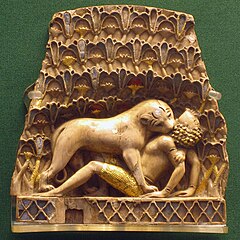Nimrud ivories

Ivory plaque from Nimrud in the British Museum. The plaque still has much of its original gold leaf and paint.
|
|
| Material | Elephant ivory |
|---|---|
| Created | 9th to 7th centuries BC |
| Period/culture | Neo-Assyrian |
| Place | Nimrud |
| Present location | British Museum, London, National Museum of Iraq, Baghdad, and elsewhere |
| Identification | 1954,0508.1 |
The Nimrud ivories are carved ivory plaques and figures dating from the 9th to the 7th centuries BC that were excavated from the Assyrian city of Nimrud (in modern Ninawa in Iraq) during the 19th and 20th centuries. Many of the ivories were taken to the United Kingdom and were deposited in (though not owned by) the British Museum. In 2011, the Museum acquired most of the British-held ivories through a donation and purchase and is to put a selection on view. It is intended that the remainder will be returned to Iraq. A significant number of ivories were already held by Iraqi institutions but many have been lost or damaged through war and looting.
The ivories mostly originated outside Mesopotamia and are thought to have been made in the Levant and Egypt. They are carved with motifs typical of those regions and were used to decorate high-status items of furniture or transportation. The ivories would have originally been decorated with gold leaf or semi-precious stones, which were stripped from them at some point before their final burial. Many were found at the bottom of wells, having apparently been dumped there during a period of war or unrest.
The first group of ivories was excavated from the site of the palace of Shalmaneser III (ruled 859–824 BC) at the Assyrian capital of Nimrud. The palace was rediscovered in 1845 by Austin Henry Layard, on the very first day of his excavations; on the second day, he made the first discovery of ivories.
More ivories were found during William Kennett Loftus's excavations in 1854–1855. They were found in a group of buildings labelled the "South-East Palace" or "Burnt Palace"; Loftus described the circumstances of the discovery in a letter to the Journal of Sacred Literature in February 1855:
The S.E. Palace at Nimroud has just yielded a large collection of beautiful ivories, relics of a throne or furniture, &c. They have been fitted together by means of rivets, slides, and grooves – a complete Assyrian puzzle, and somewhat dangerous to sit on! Many exhibit traces of gilding and enamel, and were probably broken up for the inlaid gold and jewels with which they were once adorned. There is a decided Egypto-Assyrian character about the whole collection, perfect Egyptian heads being mixed with Assyrian Bulls and Lions. The heads were very fine indeed. Some of the articles were maces, dagger-handles, or portions of chairs and tables (for we have undoubted evidence of the Assyrians using such.) Figures back to back form a shaft, and support a flower-headed capital. There are also boxes, and a vase – all elaborately carved. The Assyrians were adepts in veneering, the layers being highly ornamented with sacred emblems and lion-hunts. Phoenician inscriptions are found on two of three articles. They were found strewed at the bottom of a chamber among wood ashes. They had escaped the flames, but are blackened from lying among smouldering wood. I have got up a horse-load of objects, and am fitting them together as fast as possible, preparatory to boiling them in gelatine. The whole room is not yet explored, as the earth must first be removed from above. I propose going down to-morrow.
...
Wikipedia
